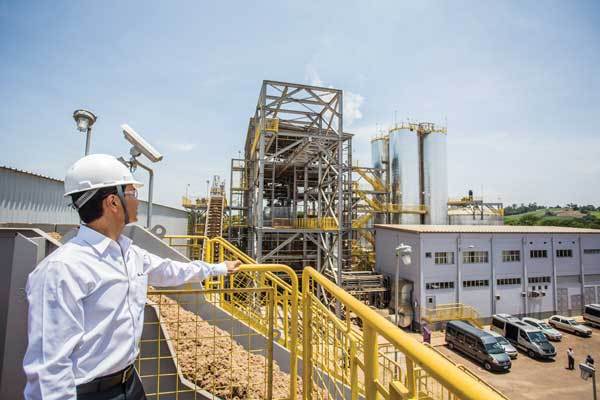Iogen's quest for reliability





PHOTO: JANA CHYTIL
March 14, 2016
BY Susanne Retka Schill
Five years ago, when Ethanol Producer Magazine interviewed CEO Brian Foody for a cover story, he described the key to realizing success in cellulosic ethanol development as being like having a hotel with a thousand rooms that need to be cleaned, each with its own key. Today, the company has its first commercial-scale facility built in Brazil and, like most other first-round cellulosic ethanol developers, is systematically finding the keys to the remaining issues.
The path to commercialization has been long and circuitous. Iogen Corp. was one of the first out of the gate to reach demonstration phase for its cellulosic ethanol technology at its Canadian headquarters in Ottawa. In 2004, the company announced it was selling cellulosic ethanol commercially from the plant and, in 2009, said it was the first to sell cellulosic ethanol at a retail station, albeit only for a month. In 2010, Iogen had more than 300 employees and was actively working on project development in western Canada. The company formed Iogen Energy, a joint venture with deep-pocketed partner Royal Dutch Shell.
“At the time, oil prices were high and western Canada was a very hot construction market,” Foody recalls. “We faced construction challenges but were hopeful we could bring a project forward. We did quite a bit of work, came up to the decision point and Shell top management reached a conclusion that it was too expensive in that location and not the right choice. So they canceled our project in western Canada, which led to a layoff of a large number of people here at Iogen, which was well-reported.”
Shell transferred its share in the joint venture, Iogen Energy, to Raizen, (pronounced hi-ee-san), its Brazilian joint venture with one of the country’s largest sugar producers, Cosan SA. Iogen shifted its focus to bagasse and sugarcane straw and the design of a 10 MMgy bolt-on facility. Initial startup of the facility colocated with Raizen’s Costa Pinto mill in Sao Paulo began in October 2014 and the official opening ceremonies were held last July, with the president of Brazil presiding.
Like all cellulosic developers, the commissioning process is taking months. “We’ve made very good progress,” Foody says. “We still can see success from where we’re at, but there’s a lot of holes to be buttoned up. They include things like managing the large amount of sand and stones that can come in with the feedstock, managing erosion and corrosion in the system, tightening up controls. It really is a battle of 1,000 different individual things.”
Because sugarcane is a perishable crop, the entire industry shuts down between harvest seasons. Since December, Iogen has been working through bugs and trying to simplify things, anticipating start-up for the season in late March or early April. “We have periods of continuous operations and periods of intermittent operations, and there are more intermittent periods than we would like,” Foody says. There are unique synergies with Brazil’s sugarcane ethanol industry, he adds. “We believe we can reduce operating costs and capital significantly by integrating closely with mills in Brazil.”
Addressing the long path Iogen has traveled to get to this point, Foody says, “I would say I’m an optimist. When I started in this business nobody talked about second-generation biofuels and we’re involved and one of the key competitors in a business that has seen billions of dollars of investment now. We’re driving hard with great partners to make a success of this in Brazil. Is it hard work? Sure. Have we had to persevere? Sure. We have a commercial plant up and running. We still have some work to do, but it’s up and running. We’ve made tremendous strides. Surely, not in the simple linear way we originally thought. We’ve made tremendous strides and we’re looking forward to real success.”
Foody is confident the operational challenges being faced by all second-generation companies will be met, and operational costs will meet their targeted goals as everyone turns the focus on reducing capital costs. There are storm clouds, though. “I think that the collapse in oil price creates concern among anybody doing energy development, even though the [renewable fuel standard] offers some well-structured insulation from exactly these kinds of events.”
In spite of the talk about investment dollars moving to Brazil and other countries as a result of lagging support for the RFS, Foody defends the policy. “I’m very upbeat and positive about the renewable fuel standard. It’s beginning to provide honest price signals for producers. There are now 200 million gallons worth of cellulosic biofuels made in the United States, although largely made by biogas and not cellulosic ethanol. The market signals now are working. They’re solid. I know many people in the field will complain about shortcomings on the EPA’s part. And, I think there are things they could address for more efficient operation of the RFS, but I think it’s powerful and it’s the best legislation in the world for cellulosic biofuels.”
The heightened focus on global climate change is a positive, he says. “The initiatives to reduce greenhouse gases are good for cellulosic ethanol and they will be good for corn-ethanol business, which has a lower greenhouse gas profile than gasoline. I’m sure you’ve heard or read that last year was the hottest year on record and the year before that was the second hottest on record. To the extent that there is a growing public challenge to reduce greenhouse gas emissions, as there is in California led by the Low Carbon Fuel Standard, we will see cellulosic biofuels playing a really positive role. It’s these macro forces that will allow large companies to make strategic commitments and to have the resources and commitment to see them through.”
The best thing the nascent cellulosic ethanol industry can do, he stresses, is get these first-of-their-kind facilities running smoothly. “You have a group of companies that have put down a lot of money and they’re trying to get their processes to run in a reliable way. Each group has come at this in a different way, with different amounts of investment and somewhat different process and technology strategies. In the end, right now, the principal challenge is to get steady reliability in operation so these technologies can be deployed. I think that particular challenge trumps almost everything else.”
Author: Susanne Retka Schill
Senior Editor, Ethanol Producer Magazine
sretkaschill@bbiinternational.com
701-738-4922
Advertisement
Global Developments
The Italian chemical company, Mossi & Ghisolfi Group, lays claim to being the first to bring a large, 20 MMgy cellulosic ethanol plant online at Crescentino, Italy, in 2012.
“Crescentino is now operating at industrial scale and on a daily basis, producing large quantities of cellulosic ethanol that are shipped into Europe, thanks to a long-term contract with an oil company,” says company spokesman Silvia Sacco. “The hurdles found during the first 15 months of prolonged start-up have been overcome and the actual configuration of the plant proves to be sustainable for steady state production.”
Beta Renewables is the company within the M&G group formed to license the trademarked Prosea technology. Chemtex International and Biochemtex are companies within the M&G Group developing projects, including Project Alpha in North Carolina. A Brazilian company, GranBio, was the first to license the Prosea technology and has brought its commercial-scale facility online.
GranBio’s cellulosic ethanol production began in September 2014, at Bioflex Agroindustrial in Sao Miquel dos Campos, Alagoas, Brazil. The company is using Prosea pretreatment technology from Beta Renewables in the 20 MMgy plant, enzymes from Novozymes and started up with yeast from DSM. In mid-2015, GranBio announced it had received approval for its own proprietary yeast capable of fermenting both C5 and C6 sugars present in sugarcane straw and bagasse.
GranBio’s plant was the only foreign facility registered to generate D3 RINs for cellulosic ethanol on the U.S. EPA’s Part 80 list in February. In its discussion of projected cellulosic volumes for 2016 in the final rule, EPA included GranBio in its table of plants that had not yet achieved consistent commercial-scale production. The agency projected a conservative range from zero to 2 million gallons from GranBio to be applied to the 2016 RFS volumes in the U.S.
Other projects were announced in 2014. In Europe, Energochemica, a Slovak company, bought the second license from Beta Renewables. Its plant is under construction, with startup expected in 2017. In China, M&G Chemicals and Anhui Guozhen created a joint venture to produce cellulosic ethanol and bioMEG, a base chemical used in plastics. With the big drop in oil prices affecting fuel and MEG prices, the project is being reviewed to ensure profitability is still attractive, Sacco reports. “M&G Chemicals decided that in order to optimize certain costs and yields, it is necessary to integrate design changes to the process that have been made and tested in Crescentino. Expectations are to be able to update the project economics in the second half of this year and to get the green light to start execution by year end.” Start-up is projected for late 2017. Two other projects are in earlier stages of development. One in India with CVC Infrastructures Ltd., and another in Malaysia with Brooke Renewables Sdn.
—Susanne Retka Schill
Advertisement
Related Stories
The U.S. EPA on July 8 hosted virtual public hearing to gather input on the agency’s recently released proposed rule to set 2026 and 2027 RFS RVOs. Members of the biofuel industry were among those to offer testimony during the event.
The U.S. exported 31,160.5 metric tons of biodiesel and biodiesel blends of B30 and greater in May, according to data released by the USDA Foreign Agricultural Service on July 3. Biodiesel imports were 2,226.2 metric tons for the month.
The USDA’s Risk Management Agency is implementing multiple changes to the Camelina pilot insurance program for the 2026 and succeeding crop years. The changes will expand coverage options and provide greater flexibility for producers.
President Trump on July 4 signed the “One Big Beautiful Bill Act.” The legislation extends and updates the 45Z credit and revives a tax credit benefiting small biodiesel producers but repeals several other bioenergy-related tax incentives.
CARB on June 27 announced amendments to the state’s LCFS regulations will take effect beginning on July 1. The amended regulations were approved by the agency in November 2024, but implementation was delayed due to regulatory clarity issues.
Upcoming Events










